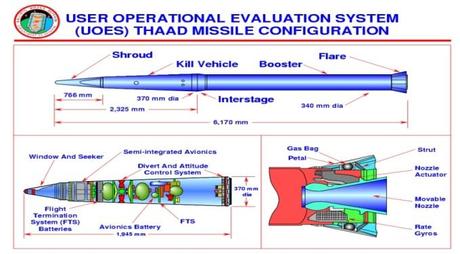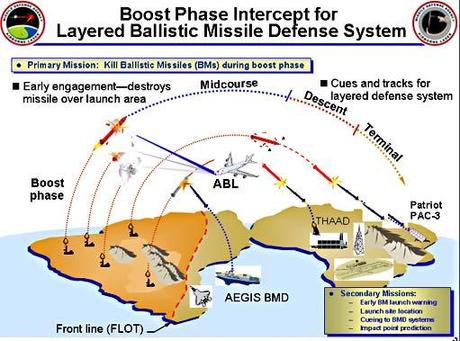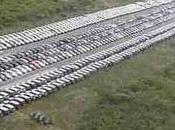In the beginning of April, the White House was notified of intelligence information specifically stating that the threats coming from North Korea were to be taken seriously. Likely targets of a North Korean strike are to be considered the island of Guam and Okinawa in Japan. Both of those islands have a strong US military presence and are strategically positioned in the Asian-Pacific arena. In particular Guam is considered a prime target due to its status as an unincorporated territory of the United States in the western Pacific Ocean. The intelligence assessment considered more feasible an attack on Guam than a strike on the continental US.
The striking capabilities of North Korea are not totally clear, but looking at highly sensitive space/satellite images the USA Department of Defense reports that missiles, with which North Korea plan to strike, are part of the family of the No-Dong/Musadan, specifically the No-Dong class B. The No-Dong B is the newest version of the No-Dong family.
According to intelligence reports, the No-Dong B is approximately 12 meters long and half a meter in diameter. It appears that the class B is slightly smaller than the rest of the missiles of the No-Dong family. The difference compared to the other No-Dongs is the longer range and the mobility of the class B which can be launched from a moving vehicle. Estimates of its range vary from a low estimate of 2,700 kilometers to a high of 4,000 kilometers. The class B is potentially capable of reaching the American military bases in Guam and Okinawa.
Several No-Dong B missiles were discovered being carried by train throughout the country to their launch sites. Looking at the pictures in detail, it appears that the missiles have an engine compartment and a propellant tank along with an extra component similar the No-Dong-A/1 which will give the class B an extra stage element as a re-entry vehicle. By adding the propellant tank and the re-entry vehicle, No-Dong B might be capable of reaching another thousand kilometers, which is a good extra range capability additive, but yet not enough to reach the critical parts of the U.S. Under the current military hardware, North Korea has not yet developed the capability of reaching the continental U.S. The mass media news frenzies about possible Los Angeles or San Francisco targets are overblown and totally incorrect.
Having clarified that there is no potential for reaching the continental U.S., the North Korean missiles still have the range for Guam and Okinawa. Okinawa, although it is in Japanese territory, is one of the most important US military areas, making it a prime target. So is the island of Guam, which is not only an American possession, but is also the site of three important military bases: Andersen Air Force Base at Yigo, Naval Base at Apra Harbor and Naval Forces at Marianas.
Having established the possible targets of a North Korean strikes and having solid intelligence information (although not complete) about the capability of North Korea, the White House has fully unleashed the U.S. military machine. The Nobel peace prize winner Obama, between a White House party and a golf tournament, has made clear that any hostile action by North Korea will be met with an iron fist. But while everybody is paying attention to the traditional military maneuvers of the U.S. Navy, Army, and Air Force in the pacific Asian arena, the most significant development is the deployment of the brand new Terminal High Altitude Area Defense (THAAD).
On April 3, 2013 the Department of Defense announced that the THAAD ballistic missile defense system was to be deployed to Guam. As of today April 14, 2013, the first batch of THAAD is in place and ready to intercept any missiles that are launched from North Korea. This new class of interceptors is the latest addition to the Ballistic Missile Defense System (BMDS) which is complemented by the Patriots and the AEGIES BMD system. THAAD are rapidly deployable and capable of destroying missiles inside and outside the atmosphere during their terminal phase of flight.
Here are some of the specifications of the THAAD: They are land based, mounted on moving vehicles, and high tech. They are specifically designed to destroy any incoming warhead and are very effective against any asymmetric ballistic missile threats. Their capacity to intercept incoming missiles at very high altitudes mitigates the effects of any weapons of mass destructions before they reach the ground.
A THAAD battery consists of four main elements: A launcher, the interceptors, radar, and finally the fire control. The launcher is track mounted and, therefore, highly mobile and the missiles can be rapidly fired and reloaded. There are eight interceptors for each launcher. Every interceptor is equipped with an Army Navy/ Transportable Radar Surveillance (AN/TPY-2). The radar is capable of searching; tracking, zeroing in on an object, and identifying what kind of object it is before making the decision of striking the incoming object. Each component of the THAAD is linked together with highly sensitive and sophisticated software. The THAAD is capable to scan, apply and execute multiple intercept solutions, constantly reassessing its objectives. THAAD has an altitude range of 150 kilometers.
The project of THAAD was first conceived in the early 90’s but various delays due to budgetary concerned pushed back the THAAD program. In 1992, Lockheed Martin Missiles-Space and Raytheon were awarded a $689 million contract to develop the THAAD system. Finally, the THAAD program entered the engineering and manufacturing development phase in 2000. Full production of the THAAD started in May 2004 at Lockheed Martin’s new production facilities in Pike County, Alabama. Flight tests began at White Sands Missile Range, New Mexico. The first flight test of the entire system including missile, launcher, radar and fire control system took place in May 2006. In January 2007 at Pacific Missile Range, Kauai, Hawaii there was a successful intercept test conducted in the high endo-atmosphere. Tests have continued throughout the years, including in October 2012 a combined test using all the technology and tools available in the BMDS arsenal, an integrated test to evaluate interoperability between AEEGIS BMD, THAAD, Patriots and command and control. I have to further point out that the testing of THAAD was extremely positive. Interesting enough, in 2011 the United Arab Emirates signed a $1.96 billion deal for two THAAD weapon systems and the support equipment. This is the first foreign military sale of THAAD. THAAD is considered vital for the protection of UAE against missiles treats coming from Iran.
I personally do not believe that a missile strike is going to be carried out by North Korea against US military installation or territories, but if such a strike should take place, Guam or Okinawa could become a testing ground to evaluate the effective capabilities of the North Korean missiles delivering and striking systems and to evaluate the USA’s military leap into the future with the THAAD system and its effectiveness in real scenario situations.
*****************
All’inizio di aprile la Casa Bianca fu informata specificamente dai servizi che le minacce che venivano dalla Corea del Nord erano da prendersi sul serio. I probabili obiettivi dei colpi nord-coreani erano da considerare le isole di Guam ed Okinawa in Giappone. Entrambe le isole hanno una forte presenza militare americana e sono posizionate strategicamente nell’arena dell’Asia-Pacifico. In particolare Guam è considerato l’obiettivo principale in quanto territorio non-incorporato degli Stati Uniti nell’ oceano Pacifico occidentale. La valutazione dei servizi riteneva più probabile un attacco a Guam che non sugli USA continentali.
Le capacità di attacco della Corea del Nord non sono totalmente chiare, ma osservando delle immagini satellitari molto precise il Dipartimento della Difesa USA riporta che i missili che la Corea del Nord vorrebbe lanciare, fanno parte della famiglia No-Dong/Musadan, ed in particolare quelli di classe B. I No-Dong B sono la versione più recente della famiglia No-Dong.
Secondo i rapporti dei servizi il No-Dong B è lungo circa 12 metri con diametro di circa mezzo metro. Sembra che i missili classe B siano un po’ più piccoli di quelli dell’intera famiglia No-Dong. La differenza con gli altri sta nella maggiore gittata e mobilità di questi missili che possono essere lanciati da mezzi semoventi. Le stime della loro gittata vanno da un minimo di 2400 km ad un massimo di 4000 km. La classe B è potenzialmente in grado di raggiungere le basi americane a Guam ed Okinawa.
Diversi missili No-Dong B sono stati scoperti mentre erano trasportati via treno attraverso la nazione verso i loro siti di lancio. Guardando le foto in dettaglio, si osserva che i missili hanno un comparto motore ed un serbatoio di propellente insieme ad un componente ulteriore simile al No_Dong A/1 che fornisce al classe B un ulteriore stadio come veicolo di rientro. Con l’aggiunta del serbatoio di propellente e del veicolo di rientro, il No-Dong B potrebbe essere capace di aggiungere altri mille kilometri di gittata, che è un buon risultato, ma non ancora sufficiente per raggiungere parti critiche degli USA. Con le attuali apparecchiature militari la Corea del Nord non ha ancora sviluppato la capacità di raggiungere gli USA continentali. Le smanie dei media su possibili obiettivi come S.Francisco o Los Angeles sono esagerate e totalmente sbagliate.
Chiarito che non c’è alcuna possibilità di raggiungere gli USA continentali, comunque, i missili nord-coreani hanno la gittata per raggiungere Guam e Okinawa. Okinawa, anche se in territorio giapponese, è una delle più importanti aree militari americane, rendendola un obiettivo primario. Lo stesso per Guam, che non solo è un possedimento USA, ma è anche sede di tre basi militari importanti. La base aerea Andersen a Yigo, la base navale nel porto di Apra e le forze navali a Marianas.
Stabiliti i possibili obiettivi dell’attacco nord-coreano e con solide informazioni dei servizi (ancorché non complete) sulle capacità della Corea del Nord, la Casa Bianca ha scatenato pienamente la macchina militare. Il vincitore del Nobel per la pace Obama, fra un ricevimento ed un torneo di golf, ha chiarito che ogni azione ostile della Corea del Nord sarà contrastata col pugno di ferro. Ma mentre tutti rivolgono la loro attenzione alle tradizionali manovre della marina, dell’esercito e dell’aviazione nell’arena asiatica, lo sviluppo più significativo è lo spiegamento del nuovissimo THAAD (Difesa dell’Area Terminale ad Elevata Altitudine).

Il 3 aprile 2013 il Dipartimento della Difesa ha annunciato che il sistema di difesa anti-missili balistici THAAD era stato dispiegato a Guam. Dal 14 aprile la prima unità THAAD è in posizione e pronta ad intercettare qualsiasi missile possa essere lanciato dalla Corea del Nord. Questa nuova classe di intercettori è l’ultima aggiunta al Sistema di Difesa anti-Missili Balistici (BMDS) che è completato dai Patriots e dal sistema AEGIES BMD. I THAAD sono dispiegabili rapidamente e capaci di distruggere missili sia dentro che fuori l’atmosfera durante la fase finale del loro volo.
Ecco alcune delle caratteristiche del THAAD. I missili sono basati a terra, montati su veicoli semoventi e ad alta tecnologia. Sono specificamente progettati per distruggere qualsiasi testata bellica e sono molto efficaci contro qualsiasi minaccia asimmetrica di missili balistici. La loro capacità di intercettare i missili in arrivo ad altitudini molto elevate, mitiga gli effetti di ogni arma di distruzione di massa prima che arrivino a terra. Una batteria THAAD consiste di quattro elementi: un lanciatore, gli intercettori, il radar ed infine il controllo del fuoco. I lanciatori sono montati su camion e quindi molto mobili, i missili possono essere facilmente sparati e ricaricati. Ci sono otto intercettori per ogni lanciatore. Ogni lanciatore è provvisto di un AN/TPY-2 (sistema di sorveglianza radar). Il radar è in grado di cercare, seguire e puntare un oggetto e di identificare di che tipo di oggetto si tratti prima di decidere di colpire l’oggetto in arrivo. Ogni componente del THAAD è connesso a mezzo di software estremamente sensibile e sofisticato. Il THAAD è capace di esplorare, applicare ed eseguire soluzioni di intercettazione multiple, ridefinendo continuamente i suoi obiettivi. THAAD ha un’altitudine operativa di 150 km.

Il progetto THAAD è stato inizialmente concepito nei primi anni ‘90 ma vari ritardi per ragioni di budget lo avevano rallentato. Nel 1992, Lockeed Martin Missiles-Space e Raytheon hanno ottenuto un contratto di 689 milioni di USD per sviluppare il sistema THAAD. Alla fine il programma THAAD entrò nella fase di sviluppo progettuale e costruttiva nel 2000. La piena produzione del THAAD cominciò nel marzo 2004 nei nuovi impianti Lokheed Martin a Pike County, Alabama. Le prove di volo incominciarono nella base di White Sands Missile Range nel New Mexico. Il primo test di volo del sistema completo incluso missile, lanciatore, radar e sistema di controllo ebbe luogo nel maggio 2006. Nel gennaio 2007 nella base Pacific Missile Range, a Kauai, nelle Hawai ci fu un test positivo di intercettazione condotto nella elevata endo-atmosfera. I test sono continuati negli anni incluso, nell’ottobre 2012, un test combinato utilizzando tutta la tecnologia e le apparecchiature dell’arsenale BMDS, un test integrato per valutare l’interoperabilità fra AEEGIS BMD, THAAD, Patriots e il sistema di comando-controllo. Occorre dire che il test del sistema THAAD è stato estremamente positivo. Interessante che nel 2011 gli Emirati Arabi Uniti (EAU) abbiano firmato un accordo da 1,96 miliardi di USD per due sistemi d’arma THAAD e apparecchi di supporto. Questo è il primo contratto di vendita estero del THAAD. Il THAAD è considerato vitale per la protezione degli EAU contro le minacce missilistiche provenienti dall’Iran. Personalmente non credo che la Corea del Nord stia preparandosi ad eseguire una attacco contro installazioni militari o territori americani, ma se un tale attacco avvenisse, Guam e Okinawa potrebbero diventare campi di prova per valutare le reali capacità dei sistemi di dispiegamento e lancio dei missili nord-coreani e per valutare il salto militare americano nel futuro con il sistema THAAD e la sua efficacia in situazioni di scenario reale.






